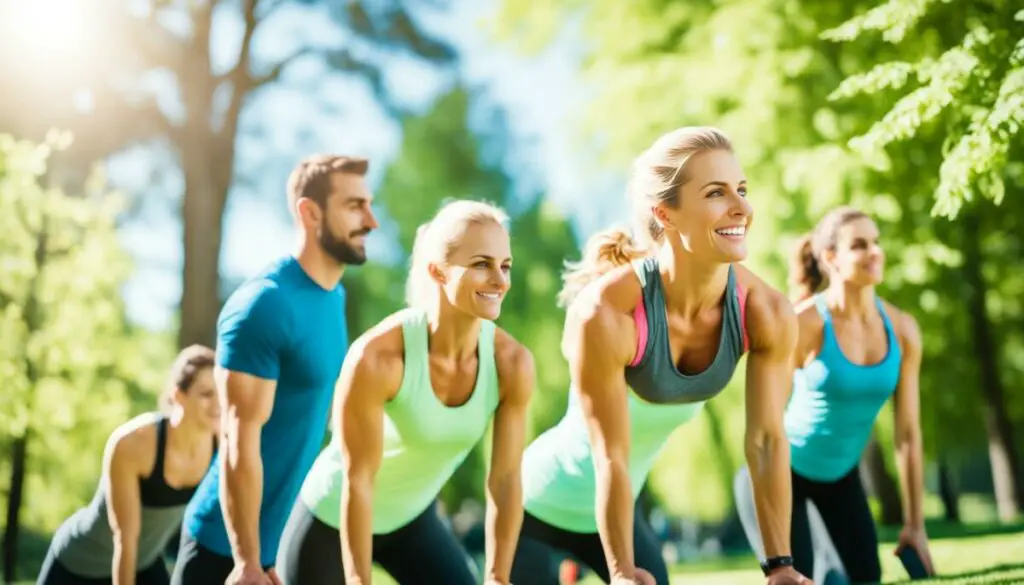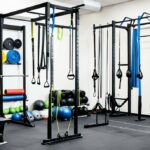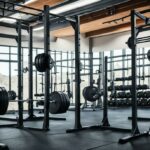Last Updated on 3 months by Francis
Are you looking to build muscle, sculpt your body, and achieve a lean and chiseled physique? Look no further than calisthenics, a fitness training method that utilizes gravity and bodyweight leverage to challenge your fitness level. Calisthenics, also known as the “street workout,” offers a wide range of benefits, from improving functional strength and flexibility to providing a full-body workout.
Unlike traditional weight training, calisthenics does not require expensive equipment or a gym membership. You can do calisthenics exercises anywhere, from your local park to the comfort of your own home. By targeting multiple muscle groups simultaneously, calisthenics helps you develop a well-toned and defined physique.
Contents
Key Takeaways:
- Calisthenics is a form of fitness that utilizes gravity and bodyweight leverage to challenge your fitness level.
- It improves functional strength, flexibility, mobility, and overall body composition.
- Calisthenics workouts often involve compound movements that work multiple muscle groups at once, providing an efficient and effective form of exercise.
- Calisthenics is a versatile training method that can be practiced outdoors and does not require expensive equipment.
- Consistency and dedication are key to achieving a lean and sculpted physique through calisthenics workouts.
What is Calisthenics?

Calisthenics is a form of fitness that combines gravity and bodyweight leverage to challenge your fitness level. It originated as a method of promoting health and strength in school children but has evolved into a training method similar to gymnastics. Unlike gymnastics, calisthenics can be practiced outdoors and is often referred to as a “street workout.” It utilizes movements that mimic natural body movements such as pushing, pulling, squatting, and jumping.
The Benefits of Calisthenics

Calisthenics offers a wide range of benefits that make it a popular choice for fitness enthusiasts. Whether you’re a beginner or a seasoned athlete, incorporating calisthenics into your workout routine can bring about significant improvements to both your physical and overall well-being. Let’s explore some of the key benefits of calisthenics:
1. No Equipment Necessary
One of the major advantages of calisthenics is that it requires little to no equipment. Unlike traditional weight training, calisthenics utilizes your own bodyweight as resistance, making it accessible to everyone. This means you can perform calisthenics exercises anytime, anywhere, without the need for expensive gym equipment or memberships.
2. Functional Strength
Calisthenics focuses on movements that mimic natural body movements, such as pushing, pulling, squatting, and jumping. By incorporating these functional movements into your workout routine, you can improve your overall strength and enhance your ability to perform everyday tasks with ease.
3. Flexibility and Mobility
Regularly practicing calisthenics can help improve your flexibility and mobility. The dynamic movements and full range of motion involved in calisthenics exercises help increase muscle flexibility and joint mobility, reducing the risk of injuries and enhancing your overall athletic performance.
4. Lean Muscle Mass
Calisthenics is an effective way to build lean muscle mass. The compound movements utilized in calisthenics engage multiple muscle groups simultaneously, leading to increased muscle activation and growth. By incorporating calisthenics into your workout routine, you can sculpt and define your physique while achieving a toned and muscular body.
5. Full-Body Workout
Calisthenics workouts provide a comprehensive full-body workout experience. The combination of compound movements and high-intensity circuits targets various muscle groups, ensuring that no muscle is left untrained. By engaging your entire body, you can enjoy the benefits of a more efficient and effective workout in less time.
Overall, calisthenics is a versatile and accessible form of exercise that offers numerous benefits. Whether you’re aiming to improve your strength, flexibility, or body composition, calisthenics can help you achieve your fitness goals without the need for extensive equipment or gym memberships.
So why wait? Start incorporating calisthenics into your fitness routine and experience the incredible benefits it has to offer!
Calisthenics Versus Weight Training

When it comes to fitness, there are two popular training methods that often come into consideration: calisthenics and weight training. Both of these exercises offer unique benefits and can be effective in their own ways. Let’s take a closer look at the advantages of each.
Weight Training:
Weight training typically involves the use of dumbbells or barbells to apply external resistance to the muscles. This form of exercise is often associated with targeted hypertrophy, allowing you to isolate and focus on specific muscle groups. By increasing the weight progressively, you can promote muscle growth and sculpt your physique to your desired aesthetic goals. Weight training is commonly used by bodybuilders and athletes who emphasize muscle development for competition.
Calisthenics:
On the other hand, calisthenics utilizes bodyweight movements to build functional strength and overall athleticism. It involves performing exercises such as push-ups, pull-ups, squats, and lunges that engage multiple muscle groups simultaneously. Calisthenics works the body as a whole, promoting better coordination, balance, and flexibility. Unlike weight training, calisthenics can be performed anywhere without the need for equipment, making it a highly accessible and versatile workout option.
One of the key advantages of calisthenics is its ability to burn calories effectively. Calisthenics workouts often incorporate high-repetition ranges and circuits, which increase the total energy output and help in achieving optimal calorie burn. This makes calisthenics an excellent choice for individuals looking to lose weight or improve their cardiovascular fitness.
Overall, both calisthenics and weight training have their own merits. If you’re primarily aiming for targeted muscle growth and sculpting, weight training may be the way to go. However, if you’re looking for functional strength, athleticism, and an efficient way to burn calories, calisthenics can be an excellent choice.
| Calisthenics | Weight Training |
|---|---|
| Utilizes bodyweight movements | Uses external resistance |
| Improves functional strength and athleticism | Emphasizes targeted muscle growth |
| Burns calories effectively through high-rep ranges and circuits | Allows for isolation and targeted hypertrophy |
| Can be performed anywhere without equipment | Requires dumbbells or barbells for resistance |
Whichever training method you choose, it’s important to set specific goals and tailor your workout routine accordingly. Combining aspects of both calisthenics and weight training can also create a well-rounded fitness program that meets your individual needs and preferences. The key is to find a routine that you enjoy and can stick to consistently, as consistency and dedication are the keys to progress and achieving your desired fitness goals.
What Studies Say About Calisthenics

A scientific study conducted by scientists from the University of Palermo in 2017 has shed light on the effectiveness of calisthenics training in improving posture, strength, and body composition. The study involved 28 men who were divided into two groups – one group practiced calisthenics for eight weeks, while the other group continued with their regular workout routines.
The researchers discovered that the men who trained calisthenics demonstrated significant improvements in posture, experienced a reduction in fat mass, and achieved increased upper body strength, despite not following a specific calisthenics exercise program during the study. This study highlights the effectiveness of calisthenics in improving body composition and overall strength without the need for major training equipment.
Calisthenics for Beginners

Starting a calisthenics routine can be both exciting and daunting, especially if you’re new to bodyweight training. But don’t worry, we have you covered with this beginners guide to calisthenics. By starting with basic exercises and gradually progressing, you’ll build strength, improve form, and prepare your body for more advanced calisthenics movements.
Here are some essential exercises for beginners:
- Incline Press-Up: If you’re unable to perform a regular press-up, the incline press-up is a great starting point. Find an elevated surface like a bench or step, place your hands on it shoulder-width apart, and lower your chest towards the surface while maintaining a straight back. As you gain strength, gradually decrease the incline until you can perform a regular press-up.
- Dips: Dips are excellent for targeting the chest, triceps, and shoulders. You can perform dips using parallel bars, dip stations, or even two sturdy chairs. Lower your body by bending your elbows and then push yourself back up. If you’re new to dips, start with assisted or bench dips to build strength and gradually progress to full dips.
- Bodyweight Movements: Exercises like squats, lunges, and planks are fundamental to calisthenics and provide a solid foundation for your training. Squats and lunges target the lower body while planks engage your core muscles. Include these exercises in your routine to improve overall strength and stability.
- Rows: Rows are essential for developing a strong back and improving posture. With options like inverted rows using a sturdy bar or table, you can target your back muscles effectively. Focus on engaging your shoulder blades and pulling your body towards the bar or table.
Remember, consistency is key, and it’s essential to listen to your body and progress at your own pace. As you become comfortable with these basic exercises, you can gradually incorporate more advanced movements into your routine. Don’t forget to warm up before each workout and cool down afterwards to prevent injury and optimize recovery.
To get a better idea of how these exercises are done, take a look at the image below:
Calisthenics Workout for Beginners

If you’re new to calisthenics, don’t worry! You can still get a great workout and start building strength with some basic exercises. A beginner calisthenics workout is a perfect introduction to this form of exercise. It will give you the foundation you need to progress to more advanced movements.
One of the key exercises in a beginner calisthenics workout is press-ups. Press-ups, also known as push-ups, are a fantastic way to strengthen your upper body, especially your chest, shoulders, and triceps. They can be modified to suit your fitness level, making them accessible for beginners.
Squats are another essential exercise to include in your routine. Squats target your lower body, particularly your quadriceps, hamstrings, and glutes. They are a functional movement that mimics natural body mechanics and helps improve overall lower body strength.
In addition to press-ups and squats, you can incorporate other basic bodyweight movements into your beginner calisthenics workout. This may include exercises like lunges, burpees, planks, and mountain climbers, which engage multiple muscle groups and provide a full-body workout.
Here’s a sample routine that you can follow as a beginner:
- Warm-up: 5-10 minutes of light cardio or dynamic stretches.
- Main Workout: 2-3 rounds of the following exercises:
| Exercise | Reps |
|---|---|
| Press-Ups | 8-12 |
| Squats | 12-15 |
| Lunges | 8-12 each leg |
| Burpees | 8-10 |
Remember to listen to your body and adjust the number of reps based on your ability and progression. Take 2 minutes of rest between rounds to recover.
By following this beginner calisthenics workout, you’ll start building strength, improving your fitness level, and laying the foundation for more advanced calisthenics movements. Don’t forget to maintain proper form and technique to avoid injury and get the most out of your workout.
Now, let’s dive into the calisthenics body and how this form of training can help you achieve a sculpted physique.
The Calisthenic Body Is The Cohesive Body

The calisthenic body is characterized by a rippled, muscular build, erect posture, balanced development, and low body fat. Unlike workouts that isolate small body parts, calisthenics celebrates the power of full-body movements that engage multiple muscle groups simultaneously. By emphasizing strength and tension from the entire body, calisthenics allows for a more balanced and aesthetically pleasing physique.
Through the use of bodyweight exercises, calisthenics promotes muscle mass development while keeping body fat levels in check. This approach not only results in a lean, toned appearance but also enhances overall functional strength and endurance.
Benefits of Full-Body Movements
Full-body movements, such as push-ups, pull-ups, and squats, engage various muscle groups in a coordinated and integrated manner. This approach develops a balanced physique by ensuring that no single muscle group is neglected.
In contrast, exercises that target specific muscles in isolation can lead to muscular imbalances, which may affect posture and overall body symmetry. Calisthenics focuses on exercises that recruit multiple muscle groups simultaneously, ensuring that the body develops proportionately.
Calisthenics is not just about building muscles; it is about achieving a harmonious and functional body. By incorporating full-body movements into your training routine, you can develop a physique that is not only aesthetically appealing but also strong and capable in various functional movements.
Calisthenics Training Principles
- Compound Movements: Calisthenics primarily consists of compound movements that involve multiple joints and muscle groups. This approach improves overall muscle coordination and promotes balanced development.
- Progressive Overload: To continually challenge the body and stimulate muscle growth, calisthenics training employs progressive overload principles. This involves gradually increasing the intensity, volume, or difficulty of exercises over time.
- Bodyweight Resistance: Calisthenics relies on the resistance provided by one’s bodyweight. This allows for natural and functional movements that engage stabilizer muscles and improve overall strength and control.
- High Repetitions: Calisthenics often involves higher repetition ranges, which leads to increased muscular endurance and helps reduce body fat levels.
By following these principles and incorporating full-body movements into your calisthenics routine, you can achieve a well-rounded physique that demonstrates both strength and aesthetics.
Maintaining Body Fat Levels
In addition to building muscle mass, calisthenics training helps promote a healthy body fat level. As full-body movements engage multiple muscle groups, they require significant energy expenditure, leading to improved calorie burning and fat loss.
Moreover, calisthenics workouts often incorporate high-intensity interval training (HIIT) techniques, which have been shown to effectively reduce body fat and improve cardiovascular fitness.
| Benefits of Calisthenics for Body Composition | Benefits of Calisthenics for Overall Fitness |
|---|---|
| – Builds lean muscle mass | – Improves functional strength |
| – Reduces body fat | – Enhances flexibility and mobility |
| – Provides a balanced physique | – Increases cardiovascular endurance |
| – Promotes muscular symmetry | – Develops body control and coordination |
Calisthenics Abs, Arms, Back, Shoulders, and Chest
Calisthenics exercises are a great way to target and strengthen various muscle groups, including the abs, arms, back, shoulders, and chest. By incorporating these exercises into your workout routine, you can develop a well-rounded and muscular physique.
Abs
To build a strong and defined core, focus on exercises such as hanging leg raises and windshield wipers. These movements engage the abdominal muscles and help improve both strength and aesthetics.
Arms
For strong and impressive arms, incorporate bar work exercises such as chin-ups and muscle-ups into your routine. These movements target the biceps, triceps, and forearms, helping you develop toned and muscular arms.
Back
Wide lats and a strong back can be achieved through exercises like pull-ups and rows. These movements target the muscles in the upper, middle, and lower back, helping you develop a well-defined and powerful back.
Shoulders
To strengthen your shoulders, focus on exercises that involve pushing and pulling movements. Movements like handstand push-ups and pike push-ups target the deltoids and other shoulder muscles, helping you develop strong and broad shoulders.
Chest
For a powerful chest, incorporate exercises like push-ups, bar levers, and dips into your routine. These movements target the pectoral muscles, helping you develop a well-defined and impressive chest.
Remember, proper form and progression are essential for maximizing the development of these muscle groups. Start with exercises that match your current fitness level and gradually increase the intensity as you get stronger.
| Muscle Group | Exercises |
|---|---|
| Abs | Hanging leg raises |
| Windshield wipers | |
| Arms | Chin-ups |
| Muscle-ups | |
| Back | Pull-ups |
| Rows | |
| Shoulders | Handstand push-ups |
| Pike push-ups | |
| Chest | Push-ups |
| Bar levers | |
| Dips |
Confidence
Calisthenics training is not just about building physical strength; it also has a profound impact on an individual’s confidence and self-belief. As you progress in your calisthenics journey, mastering challenging bodyweight exercises, you will start to realize the incredible feats your body is capable of. This newfound bodyweight strength and control instills a deep sense of confidence in your abilities.
Furthermore, the physical manifestations of a calisthenic physique, sculpted and defined through bodyweight exercises, can greatly contribute to your confidence. The visible results, such as well-developed muscles and an impressive level of relative strength, serve as a constant reminder of your hard work and dedication.
Not only do you feel confident in your physical appearance, but the mastery of calisthenics movements also translates into overall body control and awareness. The fluidity and precision with which you perform exercises showcase your proficiency, leaving no doubt in your mind that you have achieved a level of expertise.
The posture and physique of someone who has mastered calisthenics are unmistakable and exude confidence. The strong and balanced development of muscle groups throughout the body creates a cohesive and aesthetically pleasing physique. This sense of physical empowerment spills over into other areas of your life, boosting your confidence and self-assurance in various social situations.
Ultimately, calisthenics training provides a journey of self-discovery and empowerment. The confidence you gain from pushing your physical limits, developing bodyweight strength, and seeing the tangible results in your calisthenic physique is immeasurable. Embrace the challenges, embrace the process, and embrace the confidence that comes with mastering your body through calisthenics.
“Calisthenics training doesn’t just build physical strength; it builds confidence, self-belief, and a sense of empowerment. The visible results of a calisthenic physique are a constant reminder of the hard work and dedication invested. Mastering bodyweight exercises gives you the confidence to take on any challenge that comes your way.”
Conclusion
Achieving a calisthenic physique is not an easy task, but with dedication and hard work, it is possible for anyone. The key to success lies in following specific calisthenics workouts and progressively challenging oneself. By consistently pushing your limits, you can transform your physique and develop functional strength, flexibility, and overall athleticism.
One of the unique benefits of calisthenics is the ability to work out anywhere, without the need for equipment. This makes it an appealing workout method for those looking to achieve a lean and sculpted physique. Additionally, calisthenics emphasizes full-body movements, which not only improve posture but also target multiple muscle groups simultaneously, leading to a more balanced development.
However, achieving a calisthenic physique requires more than just physical effort. It demands dedication and perseverance. Consistency is key in sticking to your calisthenics workouts and pushing through the challenges. With the right mindset and a commitment to hard work, you can transform your body and achieve the calisthenic physique you desire.
FAQ
What is calisthenics?
Calisthenics is a form of fitness that utilizes gravity and bodyweight leverage to challenge your fitness level. It is a training method that shares similarities with gymnastics but can be practiced outdoors and is known as a “street workout.”
What are the benefits of calisthenics?
Calisthenics offers several benefits, including the fact that it requires little to no equipment and can be done anywhere. It improves functional strength, flexibility, mobility, and overall body composition. It also targets multiple muscle groups simultaneously, resulting in a more toned and defined physique.
How does calisthenics compare to weight training?
Both calisthenics and weight training have their own advantages. Weight training with dumbbells or barbells can be more effective for targeted hypertrophy, allowing you to isolate specific muscle groups. Calisthenics, on the other hand, is great for building functional strength and overall athleticism. It can also be more effective for burning calories.
What do studies say about the effectiveness of calisthenics?
A 2017 study conducted by scientists from the University of Palermo found that calisthenics training is an effective solution to improve posture, strength, and body composition without the use of major training equipment.
What are some beginner calisthenics exercises?
Some essential beginner exercises include incline press-ups, squats, lunges, planks, and variations of pull exercises such as rows. These exercises help build strength, improve form, and prepare the body for more advanced calisthenics movements.
What is a sample beginner calisthenics workout?
A sample routine for beginners could involve 2-3 rounds of press-ups, squats, and other exercises, with 2 minutes of rest in between rounds. The number of reps for each exercise can vary based on the individual’s ability and progression.
What is the calisthenic body?
The calisthenic body is characterized by a rippled, muscular build, erect posture, balanced development, and low body fat. It is achieved through emphasizing full-body movements that incorporate strength and tension from the entire body.
What muscle groups does calisthenics target?
Calisthenics exercises target various muscle groups, including the abs, arms, back, shoulders, and chest. Specific exercises like hanging leg raises, chin-ups, and push-ups help develop these muscle groups.
Does calisthenics training improve confidence?
Yes, calisthenics training instills a sense of confidence as individuals realize their own bodyweight strength and control. The posture and physique of someone who has mastered calisthenics exude confidence.
How can I achieve a calisthenic physique?
Achieving a calisthenic physique requires dedication and hard work. By following specific calisthenics workouts and progressively challenging yourself, you can transform your physique and develop functional strength, flexibility, and overall athleticism.








